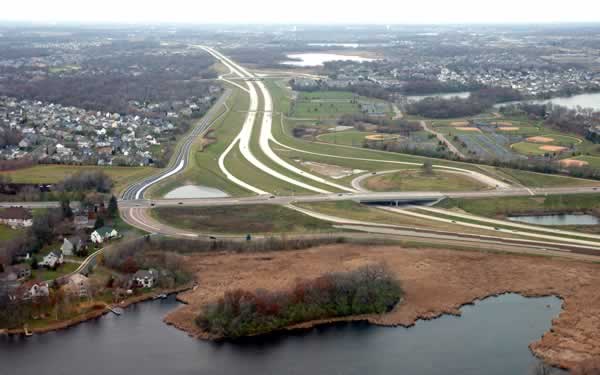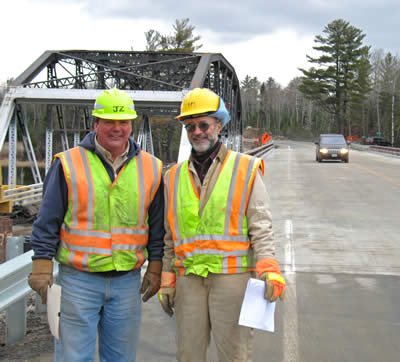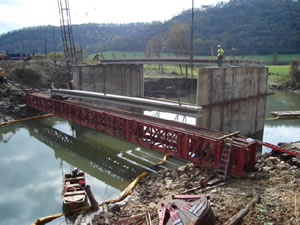
Work on Hwy 212 seen here earlier in November is progressing months ahead of schedule, according to Charles Cadenhead, project manager. “We’ve been able to complete three more miles of construction this year than we had planned,” he said. “We expect to have traffic on the new alignment of the entire 12-mile project by July 2008.” Photo by David Gonzalez |
By Craig Wilkins
Mn/DOT’s 2007 construction year was one like no other.
Events such as the collapse of the Interstate 35W bridge in Minneapolis and devastating floods in southeastern Minnesota reordered priorities and spending for the 2007 construction season.
While dealing with unexpected catastrophes, Metro District managers and construction crews completed rebuilding Hwy 36 in North St. Paul by closing the highway for five months (see separate story in this issue) and started the long-awaited reconstruction of the commons area of Hwy 62 and I-35W (the Crosstown Highway) in Minneapolis and Richfield.
Project completions in Greater Minnesota include rebuilding a section of Hwy 52 to freeway standards in Oronoco. Upgrades to the roadway include new bridges, a new overpass at County Road 12 and access control measures to improve safety and reduce crash potential.
More roundabouts were completed, including dual installations in New Prague and Cottage Grove.
New river crossings were completed, including the Hwy 1 bridge over the Kawishiwi River near Ely.
Good weather in the early part of the year supported progress on major projects such as rebuilding Hwy 10 in Detroit Lakes, Hwy 210 in Brainerd, Hwy 60 in Bigelow and the Hwy 212 and “Unweave the Weave” projects on I-35E and I-694 in the Twin Cities.
Work on building Hwy 212 on a new alignment in the Twin Cities is ahead of schedule, according to Charles Cadenhead, project manager.
Cadenhead succeeded Jon Chiglo as the project manager after he was chosen to lead construction of the new I-35W bridge in Minneapolis.
Cadenhead attributes strong progress on the design-build project to good weather, productive relationships with the cities, counties and contractors involved in the project and the project team’s ability to adjust after key staff members were reassigned to the I-35W bridge.
“Work on building Hwy 212 is about six months ahead of schedule to opening to Hwy 41 and two months ahead of schedule overall,” he said.
“We’ve been able to complete three more miles of construction this year than we had planned,” he said. “We expect to have traffic on the new alignment of the entire 12-mile project by July 2008.”

Jim Zapolski, bridge inspector (at left), and Tim Cameron, chief project inspector, take a moment to celebrate as the first motorist drives onto the new Hwy 1 bridge over the Kawishiwi River near Ely. Photo by John Bray
|
Speaking from the Minneapolis office he shares with Flatiron-Manson, the project’s prime contractor, Chiglo said initial phases of building the new I-35W bridge are going well and at a fast clip.
“We finished pile driving this week and we’ll start working double shifts in early December to drill 90 or more shafts, most of which will be from 80 to 90 feet deep. In January, we will start to see piers and abutments coming out of the ground,” Chiglo said.
The project’s fast start, he said, stems from support from throughout the department, staff experienced in design-build projects and a good working relationship with the contractor.
“We co-house with the contractor,” Chiglo said. “Sharing space allows us to meet whenever we need to resolve issues quickly. We get along very well,” he said.
“We have very aggressive goals for this project; the support we receive from the districts and other offices will enable us to meet them,” he said. “I’m confident we’re going to reach them just as we have with other design-build projects such as Hwy 212 and the ROC 52 project in Rochester.”
Tom Ravn, acting director of Construction and Innovative Contracting, added, “We created a war room at Waters Edge one day after the I-35W bridge fell to brainstorm how to begin the replacement process. Fortunately, our team included three experienced design-build project managers and Jay Hietpas, the department’s design-build program manager.
“The team worked 12- to 15-hours days for assembling design-build contract documents. Their work continues at an accelerated pace because of the project’s schedule and the time required to defend the design-build, best-value procurement process,” he said.
Ravn notes the decision to use the design-build process until awarding the contract took only 68 days.
The expected completion date for the bridge is Dec. 24, 2008.
Swept away: flooding in southeastern Minnesota
A disaster of a different kind—flooding—also required Rochester/District 6 to reorder priorities.

A bridge worker prepared to guide a beam into place on the new Hwy 76 bridge over Money Creek near La Crescent in Houston County. The old bridge was destroyed by extensive flooding late this summer. The new bridge was built in less than two months. Photo by Paul Schauer
|
District 6 responded quickly to replace a bridge on Hwy 76 over Money Creek, located near the town of Money Creek that was swept away by massive flooding. The new bridge was built in only two months, with crews working six days per week.
District staff identified 300 locations on highways and bridges that sustained damage. Fourteen highways sustained extensive damage and a number of bridges required substantial repairs as well.
Maintenance crews led the repair efforts until mid-October, when they refocused their work to prepare for winter operations.
Kristine Hernandez, public affairs coordinator, said the district met its goal to have all of the damaged roads and bridges useable by Thanksgiving Day.
Ravn said innovation and a shared commitment to succeed drive many of Mn/DOT’s initiatives and accomplishments and reflect well on its employees’ ability to meet a unique set of challenges this year.
“Mn/DOT people pulled together remarkably well in response to the bridge collapse and the extensive flooding in southeastern Minnesota while facing the more everyday challenges of a construction season,” he said.
Creativity and ingenuity
Throughout the state, construction crews exhibited creativity and ingenuity in dozens of projects.
In District 1, building a new bridge over the Kawishwi River involved moving the old structure by winching it on metal plates so the new bridge could use the existing alignment.
The project also included rebuilding 4.5 miles of twisty, hilly Hwy 1 near Ely to improve its safety and capacity.
“We reached a compromise among those who wanted to leave the road as it is and those who wanted only to increase capacity,” said Chuck Saline, project manager. “We repaired rough surfaces, reduced ditch slope angles, widened shoulders and improved alignments while keeping the road’s rustic look and feel.”
In order to better manage traffic on New Prague’s rapidly growing east side, District 7 designers created a set of roundabouts on Hwy 19.
“We’re using the double roundabouts and one signalized intersection to funnel traffic toward downtown. They slow vehicle speeds and alert drivers they are approaching a downtown area to watch for local traffic including pedestrians,” said Mary Dieken, a design engineer.
Several projects addressed downtown-related traffic issues such as traffic congestion, safety and limiting the number of access points to major roadways.
Willmar/District 8 completed its reconstruction of Hwy 7, Hwy 15 and Hwy 22 in Hutchinson . Improvements in the fast-growing McLeod County city include a new Hwy 15 bridge and expansion of a section of Hwy 7 in the city to four through-lanes and a turn lane.
District 8 also finished rebuilding the intersection of Hwy 68 and Hwy 59 in the heart of downtown Marshall. The busy crossing received a makeover that includes repaving, a new traffic signal system and updated street lighting and sidewalks.
The first stage of rebuilding Hwy 34 in Park Rapids was completed by Bemidji/District 2. The safety improvement project includes a four-lane roadway with a center turn lane, two bicycle lanes, new street lights and traffic signals at Hwy 34’s intersections with Main Avenue and Hwy 71.

The community’s sentiments about rebuilding Hwy 10 in Staples are reflected in this sign at a Dairy Queen in the downtown area. Photo by Lynn Nielsen
|
Staples, a city in the Hwy 10 corridor, reflects major changes associated with widening the highway to four lanes. After the city rejected a proposed bypass, work began to improve Hwy 10 on new alignment in the city.
District 3 officials note that average daily traffic on the heavily used recreational highway in Staples will increase from the current 11,900 to 16,500 by 2030.
The project provides four lanes of new roadway, turn lanes and other safety improvements and a signalized intersection with Hwy 210. A small section of Hwy 10 west of the city will be completed next year.
North and west of Staples, major gains were made in reconstructing Hwy 10 through Detroit Lakes. The project includes moving BNSF railroad tracks 50 feet north and rebuilding the highway parallel to them.
Shiloh Wahl, Hwy 10 project manager with District 4, said progress continues on schedule.
“We stopped grading work Nov. 27 because temperatures fell almost to zero,” Wahl said, “but we’ve made a lot of major strides. We opened the Roosevelt Avenue railroad underpass and our storm water treatment systems are working well.”
In addition, Wahl said the project also rerouted the Pelican River ’s channel underneath the railroad tracks, frontage roads and Hwy 10 through a 9 by 16 foot culvert.
The culvert will reduce back-ups from flooding that occurs each spring.
The district worked with the Pollution Control Agency and the Department of Natural Resources to ensure the re-routed river would not affect fish spawning.
“The culvert has a stone bottom and boulders spaced along the route to create a more natural environment for the fish,” Wahl said.
Project leaders worked with city officials and the department’s landscape architects to choose the design for a rock wall on the north side of Big Detroit Lake which borders the highway.

Grading proceeded apace a few miles south of the Minnesota border in Iowa as part of rebuilding five miles of Hwy 60 that includes a bypass for the city of Bigelow. Photo courtesy of District 7
|
A model created by Scott Robinson, Site Development Unit, helped area residents choose the design by making various options easy to visualize.
The Hwy 10 project will be completed next fall.
Mankato/District 7 also took an innovative approach to rebuilding about five miles of Hwy 60 near Bigelow on the Iowa border.
To complete the Bigelow bypass and other improvements, the district obtained permission from the Minnesota Legislature and Iowa officials to rebuild Hwy 60 in Iowa just south of Bigelow. The project will be completed in 2008. Mn/DOT and the Iowa DOT will share the project’s cost.
|



